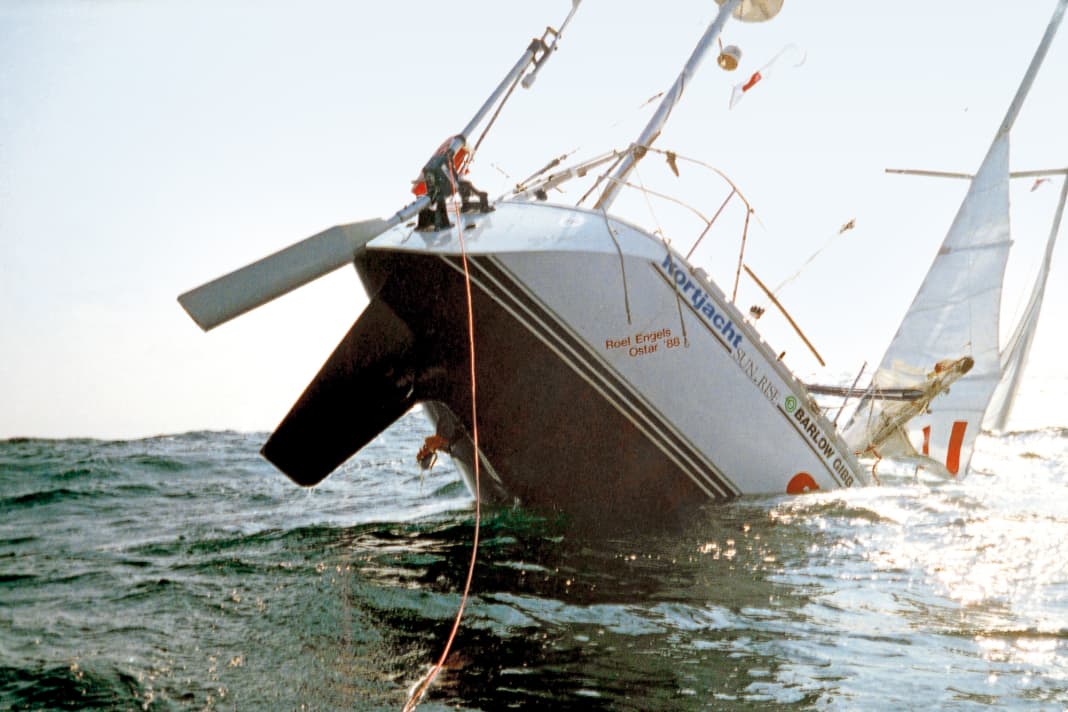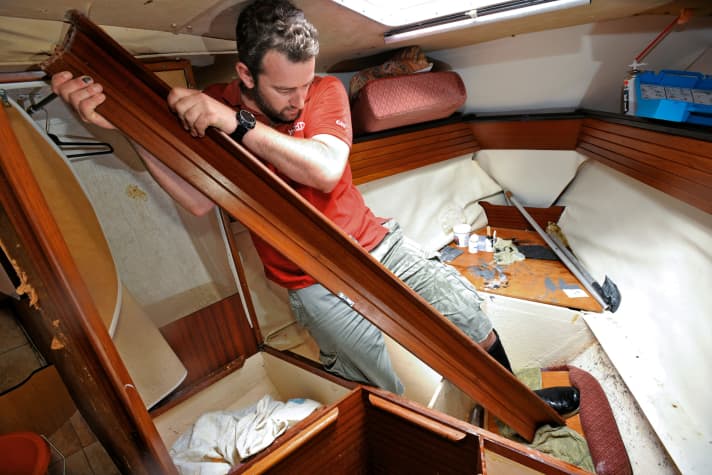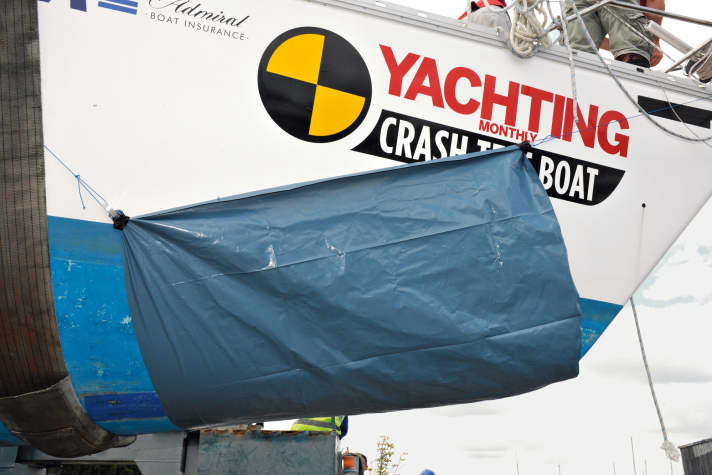





Water ingress on sailing yachts rarely appears as a cause of damage in damage statistics. There are several reasons for this: If the crew manages to stop the leak and repairs are carried out at the next opportunity, the matter goes virtually unnoticed by the public. If, on the other hand, a ship sinks, the reasons for the water ingress are usually almost impossible to reconstruct. Or they are known and the case is managed accordingly, for example as a grounding or collision. At the end of last week, for example, a Dutch yacht collided with a fairway buoy off Scharhörn. The German Maritime Search and Rescue Service (DGzRS) was only able to save the ship from sinking by using powerful pumps.
But even without such dramatic consequences, leaks on sailing yachts are part of everyday life - there is hardly a sailor who has not had to deal with serious leakage problems. If they are noticed early on and the crew manages to rectify them with on-board resources, such an incident is not remembered as life-threatening. The real emergency scenarios in which the floorboards float up without it being known where the water is coming from, on the other hand, are a nightmare for every sailor. And anyone looking for reports of such situations will quickly find what they are looking for.
Multiple challenges in an emergency
All of this is reason enough to ask yourself how you can best protect your ship from water ingress and prepare yourself and your crew for an emergency.
If a leak occurs, the crew is usually faced with several problems at once. The biggest is the high speed at which the water makes its way into the ship. This means that there is usually a considerable amount of water on board by the time the crew realises their perilous situation. However, the large amount of water makes the search more difficult, the success of which in turn determines whether the leak can still be tackled in time.
While the crew is trapped in this vicious circle, the aim is to pump as much water back outboard as possible - and as quickly as possible. Conventional bilge pumps soon reach their limits.
To get an idea of the amount of water entering, imagine an onboard outlet for hoses with an internal diameter of 38 millimetres. This dimension can be found, for example, in the plumbing drainage system or at the toilet outlet. At a depth of half a metre, over 200 litres of water per minute flow into the ship through such an opening. This is far more than the 12-volt drainage pumps with high flow rates offered by the equipment suppliers can pump back outboard.
The most important immediate measures in the event of water ingress
If you notice water ingress, alert the entire crew immediately. They should work together systematically with assigned roles and have practised this beforehand. The first thing to do is to start all available pumps and start the engine, which supplies the on-board battery with power. The higher the water level in the ship rises, the more likely it is that it will not start because the engine electrics get wet. The emergency situation is also responded to on deck. The rule of thumb is: slow down the ship! This minimises the water pressure on the hull.
An exception to this rule is when there has obviously been a collision with flotsam and the yacht has been pushed through the sea. In this case, the leak can possibly come out of the water by means of a tack or jibe on the other bow.
As a further immediate measure, close all sea valves with the exception of those for the cockpit drainage and the engine cooling water intake. This may only be closed if the supply hose is disconnected from the valve and fed into the bilge for draining. However, this procedure is controversial, as the flow rate of the cooling water pump is very low, but the risk of the engine overheating is very high. This is because the more water there is in the boat, the more floats around in it, and it is not entirely unlikely that the cooling water hose will quickly become blocked.
Rainwater or seawater?
In saltwater areas, the taste test can be a quick, immediate measure to help get the situation under control. If the water in the ship is definitely sweet, a leak in the hull can be ruled out. Either it is rainwater that has found its way inside through leaks in the deck, or the water tanks have leaked. In practice, however, the taste test will rarely lead to a clear result, as even water from the drinking water tank can hardly be identified as such after a period of time in the bilge.
The rescue coordination centre must be informed of the position, danger situation and the status of the measures on board.
As soon as the pumps are running, it must be carefully observed whether and how the water level in the ship changes. However, the more water there is in the ship, the more difficult this is because the water pressure from outside decreases and the water therefore penetrates more slowly over time. In addition, it is easier to see whether the water level is rising in a small space such as the bilge than in a flooded saloon. Finally, as an immediate measure, the rescue coordination centre should also be informed of the position, danger situation and the status of the measures on board.
Systematic leak detection in the event of water ingress
Systematic leak detection begins in parallel with the immediate measures. First of all, the critical points in the foredeck, amidships and aft are checked. In addition to the keel bolts, these are all of the ship's outlets. It is helpful to have a laminated plan on board showing the locations.
The rudder coker, stuffing box, saildrive sleeve, all sensors for the on-board electronics or earthing plates bolted through the hull can be places where ageing processes have led to wear. This can eventually lead to significant leaks. Lightning strikes are also a possible cause of leaks at such points.
If the water ingress has occurred behind a seacock, for example in the hose system of the sanitary area, it is not easy to detect now that the valves have been closed. The engine with its exhaust and cooling system is also susceptible to leaks. Hoses or metal pipes that have been gnawed at by the ravages of time can suddenly break and allow the sea to enter the interior of the boat.
Interior fittings must be dismantled with an axe and cow foot
There are regular reports of parts of the body having to be dismantled to find leaks. This can go so far that inner shells have to be sawn open, stanchions removed or fixtures dismantled. Since minutes can make the difference between success and failure in cases of doubt, those who can get to work with heavy equipment are in the best position. Axe, cow foot and hacksaw are helpful tools.

If the water ingress was preceded by a collision with another boat or a drifting object, or by grounding, the crew usually already knows where to look for the leak.
Sometimes, however, leaks occur for reasons that nobody on board expects. For example, if the anchor comes loose from its mount unnoticed in a storm and swell and maltreats the hull by banging back and forth on the chain.
Seal the leak and pump out the water
Once the leak has been found, inform the crew and press the nearest object or any part of your body against it. As the water pressure is relatively low, no great effort is required. One metre under water, it is only 0.1 bar. By comparison, an inflatable boat is inflated to 0.25 to 0.3 bar.
Once the water ingress has been stopped or at least minimised and the bilge pump is in operation, the crew can usually breathe a sigh of relief. The water level in the ship will then fall steadily and the biggest challenge in this situation, the race against time, has already been won.
You can then set about reliably sealing the leak until the next harbour. The easiest way to do this is from the inside, after the hull has been provisionally sealed from the outside with a collision mat against the water pressing on it. The principle is based on the classic leakage sail, but a plastic tarpaulin can also be used as the material, to which ropes are attached using eyelets, straps or fastening clips to bring them into position.
At any rate, this was the conclusion reached by experts from the British sailing magazine "Yachting Monthly" after they carried out various tests in 2010 on a 40-foot production yacht from the 1980s that was fitted with an artificial leak. The crash testers went to work with what they could find on board.
Even a simple film can prevent the sinking
The chapter "Sinking" in the book "The Crash Test Boat" - in which the yacht is beached, burns and explodes, among other things - ends with the conclusion that a correctly positioned insulating film, which can be purchased for as little as 20 euros, almost completely seals a leak. Provided - and this is important - that the ship is not travelling through water.

The simple explanation for this is the water pressure. The foil is positioned over the leak by the crew and the pressure does the rest. However, another realisation from the operation was that handling a leakage sail is not easy and should therefore be practised.
The best way to seal the leak depends on the circumstances, the equipment and, last but not least, the imagination and skill of the crew.
The next step is to clear the area around the leak inside the boat. Once again, it may be necessary to use a saw or axe. How and with what the opening is best sealed depends on the circumstances, the equipment and, last but not least, the imagination and skill of the crew; there is no silver bullet. And the crash test has shown that there is no standard solution even among the commercially available equipment.
The ideal case would be to apply a sufficiently strong laminate from the inside using epoxy that hardens under water. It is more likely that a large-area seal will be achieved with a self-made leak plug and wedges. The crew will also be glad to be able to reach for an axe and saw, as the interior will have to serve as material if square timbers, boards and wedges are not carried on board.
Prevention: How to prevent leaks
Even if the scenario of a water ingress is associated with the cliché of force majeure, the owner, ship's command and crew can help to prevent an emergency from occurring in the first place. Or, if it does happen, that it can be recognised early and dealt with quickly and effectively. This starts with an intensive safety briefing before setting sail. The crew members should then know where the hatches are, where the emergency equipment is stowed and how to use it. The handling of pumps and leakage sails should also be trained on this occasion.
In an emergency, it is crucial that everyone on board knows what to do
In addition to practising the use of leakage foil, tools and sealing material, it is crucial that everyone on board knows what to do in an emergency. Defined emergency roles help here; they should be worked out together, set out in writing and regularly rehearsed. It is also worth attending a safety course that includes practical leak defence training.
Weak point seacocks
The condition of the yacht is also crucial. "Water ingress usually occurs on older ships. It often has to do with wear and tear, usually in the area of the water-bearing fittings," says Holger Flindt, head of the claims department at Pantaenius, Germany's largest yacht insurance broker. This means that everything that follows a sea valve should be inspected regularly. Hoses harden over time and become cracked or porous, kink, hose clamps corrode or shake loose.
But even more recent series yachts are not immune. On the contrary: "Unfortunately, series-produced yachts are often fitted with brass through-hulls and seacocks," says Flindt. "But brass and seawater are materials that don't go well together." YACHT warned of this back in 2012: "Simple brass, a golden-yellow alloy of copper and zinc, dezincifies in salt water over time. If zinc escapes - according to the same principle by which a sacrificial anode wears out of the material - what remains is a reddish, porous copper sponge that has hardly any mechanical strength." Under load, for example when opening or closing, it then breaks. "But since the CE directive came into force, the only requirement is that water-bearing fittings must last five years. And they do," says Flindt.
The condition of the boat is not just about the state of maintenance; unprofessional installation of seawater-carrying systems can also favour unwanted water ingress. It is advisable to critically inspect everything connected to the seacocks on a regular basis. Are goosenecks, non-return valves and vents where they are required or even prescribed? Are the hose lengths in order and are the hoses secured with offset, double hose clamps? Is the water collector of the drive unit low enough?
Even if it sounds banal, even a clean bilge helps in an emergency. Firstly, because the flavour samples are then clearer, and secondly, because pumps do not clog. Of course, it must be possible to open the bilge quickly. Tightly bolted floorboards, for example, can become a serious problem in an emergency.
This equipment should be on board
The right equipment can also be crucial in the event of a leak. In addition to a manual and on-board bilge pump, a permanently installed water detector is also recommended. This sounds the alarm at an early stage if large quantities of water collect in the bilge.
One way to expand the bilge system is to install a powerful impeller pump. This is driven by the engine shaft when the engine is running. A portable, mechanical double-stroke diaphragm pump is also available on the market under the name Emergency Pump, which, according to the manufacturer Edson, delivers a good 300 litres per minute.
It is recommended that suitable softwood plugs are attached to all openings on board so that they are quickly to hand in an emergency. A sharp axe, a crowbar, a heavy hammer and a good saw should be on board a sea-going yacht, as well as other plugs and wedges. What else is carried for safety is a personal decision.
In several tests, sealants such as Leak Hero and emergency kits with epoxy that hardens under water have proven to work well. Regardless of what is chosen, the crew should always familiarise themselves with what is on board for leak defence, where it is stowed and how it is handled.

